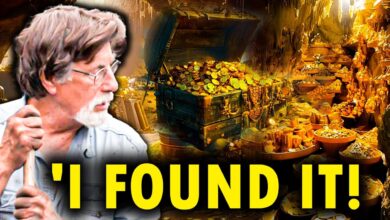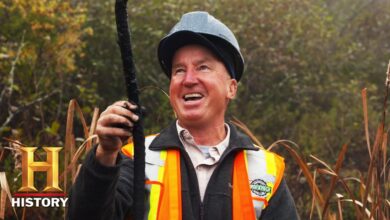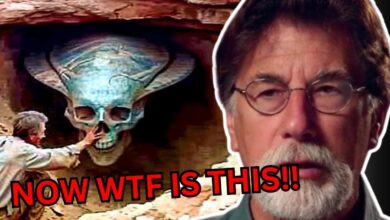The Curse of Oak Island: 17th Century English Relic Discovered?! (S12)
The Curse of Oak Island: 17th Century English Relic Discovered?! (S12)

-CRAIG: So, is this
the spoils pile right here?
-GARY: Yeah.
This is the latest one
that Billy’s guys moved around.
NARRATOR: …Craig Tester
and metal detection expert
Gary Drayton arrive on Lot 4,
located on the western side
of the island.
GARY:
All of this stuff came from
-the round feature behind us.
-Oh, okay.
NARRATOR:
They are continuing to search
through more than
ten tons of spoils
that were removed one year ago
from a mysterious
rounded stone feature
located several yards
to the east on Lot 5.
A feature where, in addition
to a mortar-like soil
that may have come
from more than 100 feet deep
in the Money Pit area,
the team has unearthed
a number of stunning artifacts,
including a fragment
of a 17th-century
English silver coin,
and a 14th-century
lead barter token
which, like the lead cross
that was discovered
at Smith’s Cove in 2017,
may be connected
to the medieval order
of the Knights Templar.
GARY:
Let’s see what
we’ve got waiting for us.
-(metal detector beeping)
-(muttering)
(beeping louder)
Oh, nice little
-signal here.
-CRAIG: That sounds good.
That looks easy digging,
right in the rock.
(Craig laughs)
-Okay, we’ll start…
-Well, actually,
it’s gotta be on top
of the rocks, in the soil.
CRAIG:
It’s so small there.
Why don’t you hit it
with your, uh, pinpointer?
GARY:
Yeah, I’ll try to pinpoint it.
(beeping)
Oh, I moved it.
Oh, I see it.
Oh, I see it.
Oh, wow, look at that.
GARY:
It’s a nice little button, mate.
-Oh, right.
-Look at that.
CRAIG:
Nice. Very round.
Does that mean anything to you?
Yeah, these rounded buttons
were normally tunic buttons.
Okay.
GARY:
Loop’s still on it, isn’t it?
CRAIG:
Yeah.
-Time period?
-(exhales)
GARY:
Could be late 1600s to mid-17s
because it is a fancier button.
This is unusual.
-We haven’t found any of those.
-CRAIG: Yeah.
NARRATOR:
A possible tunic
or garment button?
If Gary is correct that it may
date back to the 17th century,
could it be connected
to the cut English coin
that the team recently
found in the spoils
from the round feature on Lot 5?
And perhaps also help identify
who created
the original Money Pit?
That’s a nice little button.
CRAIG:
It’ll be interesting once
they clean it up,
-what they see.
-GARY: Yeah.
All right, mate,
we’ll put this in the bag.
Another great little find.
Whenever we find a button,
I get excited because
I know there’s a chance
of getting some
military insignia,
which will hopefully
help the archaeologists
track down what has been
happening on Lot 5,
and hopefully the Money Pit.
-(metal detector beeps)
-Oh, nice little
-signal here.
-Again?
GARY:
And it’s just there, mate.
CRAIG:
Okay.
Sounds like a nonferrous hit.
(beeping)
It’s out.
Great sounding signal.
Let’s see what we got.
(beeping)
What have we got here?
What have we got here, Craig?
That feels like lead.
I think I know
what that is, mate.
I think that’s a coin weight.
-Oh, really?
-That looks–
Yeah, that looks like
an old coin weight.
You see how it’s been
sloped down on four sides?
That’s what they used to do.
Slope ’em down
and cut pieces off to…
-to weigh coins.
-Okay.
Your average person
wouldn’t have one of these,
-would they?
-It would be someone,
kind of higher up.
It would’ve been the person,
like, in charge of the payroll.
-Mm-hmm.
-I would imagine that
that is an older style.
I mean, coin weights go
way, way back,
before Roman times.
But they went out of fashion,
probably, in the 1700s.
Oh, okay.
GARY: So, this could be
an old coin weight.
NARRATOR:
Prior to modern
coin minting processes,
the weight of a coin
would often vary.
Coin weights
were used by merchants
as far back as 305 BC
to ensure the true value
of the coins
they received, as well
as prevent counterfeiting.
Is it possible Gary and Craig
found a lead coin weight?
If so, might it have been used
to divide up sums of treasure,
and perhaps be related
to the high concentration
of precious metals
that have been detected
in the Money Pit area?
GARY:
That is really, really cool.
CRAIG:
Well, we’ll have to see what
the archaeologists think of it.
GARY:
Yeah.
I’ll put it in the bag.
There.
All right, mate, good digging.
-Okay.
-All right.
CRAIG:
To continue.
GARY:
Now, hopefully, we can find
-a gold coin.
-Sounds good.
LAIRD: Hey.
-Hi, guys.
-Hello.
-RICK: Good morning.
-LAIRD: Good morning.
…Gary Drayton
joins Rick Lagina,
archaeologist Laird Niven
and archaeometallurgist
Emma Culligan
in the Oak Island Lab.
Rick and Gary are eager to hear
Laird and Emma’s analysis
of the button and
possible lead weight
that were found
in the Lot 5 spoils
just one day ago.
just one day ago.
What about the button?
-Any info on the button?
-EMMA: Info on the button.
I did do a CT scan,
but that’s obscuring
the surface image.
NARRATOR: Earlier today,
Emma scanned both artifacts
using the Skyscan 1273
CT scanner,
a device which emits X-ray
radiation to produce detailed
three-dimensional
images of objects.
Additionally,
she also scanned them
with the X-ray fluorescence
spectrometer, or XRF,
to determine the elements
that make up their composition.
It’s a copper-iron alloy,
and it does have
a high content of lead in it.
No aluminum, so that’s good.
There’s no severe indicators
that it is modern.
-Okay, good.
-Yeah.
So, I would fit the composition
to 1700s to early 1800s,
-English.
-Hmm.
So, this is the best
image I could get.
LAIRD:
I think what it says
is it points more
towards a gentleman
than a farmer, again.
Yeah, yeah.
LAIRD:
And that could
tell us something about
what the round feature
was used for.
We have a lot of questions left
about the round feature.
I think what we’re finding now
supports several of the theories
that ties the deposition
of something on Oak Island
by the British military.
I feel that’s where the evidence
we have on Lot 5 is leading us.
Okay, the next one.
Yeah, I think that’s
probably the most interesting.
What do you think that is?
LAIRD:
It’s lead.
It weighs 26.2 grams.
Gary thought
it was a coin weight.
GARY:
Whenever you find a shaped
piece of metal like this,
especially if
it’s bronze or lead,
it’s usually a coin weight.
Now, this is large,
but I was thinking
maybe it’s a weight
for a large coin.
It would be a very large coin.
When you say… when you say
very large coin, what?
Well, the largest coins
back in the day,
uh, would’ve been gold.
(Rick laughs)
So start looking
at big gold coins
-’cause that would be great…
-Oh, yeah. Yeah.
…finding one of those
on Lot 5.
It’d be a big coin.
Emma has
a dissenting opinion about it.
RICK:
Oh, okay.
EMMA:
So compositionally,
I do think it’s modern.
The phosphorous content,
it’s extremely high
and you don’t see that
in lead alloys
until mid-20th century.
However,
I don’t, you know,
lead isn’t my…
-Wheelhouse.
-Yeah, wheelhouse.
So we have a conundrum
because I think
the problem with it
being modern is
we’re not finding
other modern artifacts on Lot 5.
GARY:
It really does look old.
-RICK: Yeah.
-GARY: I mean that looks
really nice and old.
LAIRD:
Yeah. I mean,
lead was used for coin weights,
but early on, too.
-Yeah.
-Like earlier,
-and then replaced
by, uh, brass.
-Mm-hmm.
LAIRD:
In general across the world,
there seems to be a transition
from lead coin weights
to brass coin weights
somewhere after 1066.
If we can prove that this
trade weight is very old,
If we can prove that this
trade weight is very old,
it puts the other old coins
we’re finding on Lot 5
into a more clearer perspective.
Emma’s analysis is suggesting
the lead weight is
more recent
than the archaeologists think,
but this is
a point where we
need to, uh, consolidate
the archaeology
and the science together
and come to a new understanding
of what this artifact is.
So I do think that it is
an excellent candidate
for laser ablation.
Great. That’s what
I was gonna say.
-EMMA: Yeah.
-It’s fantastic.
NARRATOR:
Laser ablation is
a testing method
that uses a high-powered laser
to remove a microscopic sample
from the surface of objects
that are composed of lead.
The sample is then analyzed
to determine
its specific isotope value,
which can reveal not only
where the object may have
originated but also
its approximate age.
Well, I think we can
follow this up in two ways.
The laser ablation
and finding an expert or experts
-to weigh in on this.
-Mm-hmm.
It’s a very curious find.
It feels right in your hand
for some reason.
-It’s up to you, Gary.
-Yeah. (chuckles)
Well, we got to find
some more stuff.
-We got to find some more stuff.
-Yeah.
EMMA:
I’m rooting for you guys.




